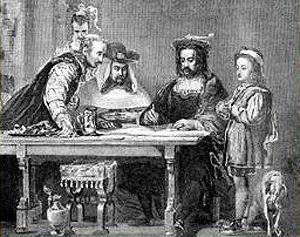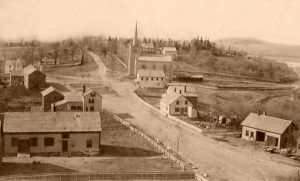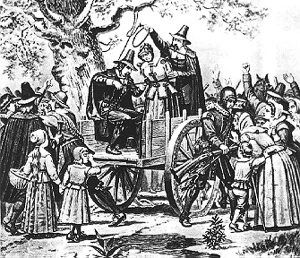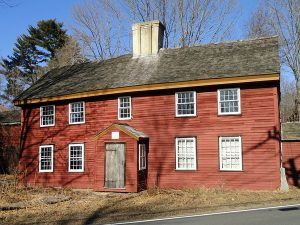Andover, Massachusetts and the Salem Witch Trials – Legends of America (original) (raw)
North Andover, Massachusetts, 1886
Located about 15 miles northwest of Salem Village, Andover started when a portion of land was set aside for an inland plantation in 1634. Early colonists were offered incentives to move to the area, and the first settlement was established in 1641 by John Woodbridge and a group of settlers from Newbury and Ipswich. In May 1646, the settlement was incorporated as a town and was named Andover, probably in honor of the town of Andover in England. The first recorded town meeting was held in 1656 in the home of settler John Osgood.
During the Salem Witch Trials of 1692, Andover, like other area villages, found itself in the midst of the hysteria. In fact, more people from Andover were accused and arrested for witchcraft than from any other town in New England.
The town’s atmosphere at the time was charged with fear of the unknown and political upheaval. The crown had revoked the Massachusetts Bay Colony charter, the differing ideologies of two pastors split the church, and Indian raids were occurring in nearby Haverhill and Billerica.
Unfortunately, the witch hysteria in Salem Village soon spread to Andover. The first accused was Martha Carrier, who was known as a strong-minded woman who would speak her mind. Unfortunately, this was not a trait admired by Puritans at the time. She was accused by her neighbor, Benjamin Abbot, after they had gotten into an argument that involved a land dispute. After the disagreement, Abbot fell sick and blamed his illness on her bewitching him and would later testify that she had killed one of his cows.
Witch Hanging
On May 28, 1692, Martha Carrier, along with her sister and brother-in-law, Mary Toothaker and Roger Toothaker, and their 9-year-old daughter, Margaret, were arrested and charged with witchcraft. On May 31, Carrier was examined by Judges John Hathorne, Jonathan Corwin, and Bartholomew Gedney. Testifying against her were several of the “afflicted girls,” including Susanna Sheldon, Mary Walcott, Elizabeth Hubbard, and Ann Putnam, Jr. She pled not guilty and accused the girls of lying. Martha’s youngest children were also coerced into testifying against their mother, and in July, she was also implicated by Ann Foster.
In the meantime, Martha Carrier’s children, including 18-year-old Richard Carrier, 15-year-old Andrew Carrier, 10-year-old Thomas Carrier, Jr., and 8-year-old Sarah Carrier, were also accused. Though her children would survive, Martha would not be so lucky. She was pronounced guilty on August 2 and hanged on August 19, 1692, along with George Burroughs, George Jacobs, Sr., John Proctor, and John Willard.
In about July 1692, Timothy Swan, a young man who was ill, began to accuse several people, including Mary Ayer Parker, Mary Tyler Post Bridges, Rebecca Blake Eames, Frances Alcock Hutchins, and others. In some of these accusations, he was joined by two of the “afflicted girls,” Ann Putnam, Jr. and Mary Walcott. Like Salem Village, the frenzy quickly spread in Andover. Between July 15 and September 7, Dudley Bradstreet, acting in his capacity as Justice of the Peace, issued some 30 arrest warrants to Andover persons who had allegedly committed the crime of witchcraft. That number would soon increase.
When the wife of Andover resident Joseph Ballard fell sick later that summer, they believed that her illness might be caused by witchcraft, and Mr. Ballard soon requested the help of two of the afflicted girls from Salem Village — Ann Putnam, Jr. and Mary Walcott — to identify who had caused his wife’s illness. After visiting Elizabeth Ballard, the girls claimed that several people in Andover had bewitched her, including Ann Foster, her daughter, Mary Lacey Sr., her granddaughter, Mary Lacey, Jr., and numerous others. The Ballards then sought the help of the Reverend Thomas Barnard, who had once been the protégé of the Reverend Cotton Mather. Both Barnard and Mather wholeheartedly believed in witchcraft and further thought that an “invisible empire” threatened the good people of the Massachusetts Bay Colony. This belief was decidedly not shared by Barnard’s co-pastor, the Reverend Frances Dane, who, from the outset, had condemned the witch hunt and trials. However, the Reverend Thomas Barnard cared little for his co-pastors opinions and had been instrumental in spreading the witchcraft hysteria and holding prayer meetings against the Devil.

The Reverend Thomas Barnard
On September 7, 1692, the Reverend Barnard ordered all those accused of witchcraft to come together at the Andover meeting house, where the “afflicted girls” were being kept. Once the accused had all been gathered, he conducted the “Touch Test,” one of the most diabolical schemes of the witch trials. At that time, it was believed that if a witch’s hand touched the body of the person they had bewitched, that person would immediately become well and could identify the witch. After reciting a prayer, Barnard then blindfolded the accused, who was then forced to go near the “afflicted girls,” who would fall into fits and cry out, claiming they were under the curse of a witch when the accused drew closer. However, when the accused touched the girls, they would immediately come out of their fit and identify the person touching them as being the one who afflicted them. This evidence was enough to cause the arrest of the accused as witches.
Justice of the Peace Dudley Bradstreet then dutifully wrote out the arrest warrants for 18 men and women accused in the touch test. These included Sarah Lord Wilson and her 14-year-old daughter, Sarah, Jr.; Mary Tyler and her daughter, Johanna; Abigail Wheeler Barker, and numerous others.
The elite of Andover were caught off guard. Captain Osgood, Deacon Frye, and other pillars of the church urged their friends and family members to confess, believing the message preached by Thomas Barnard that confession was the way to eternal life. And, “confess” they did, hoping that confession would keep them from being tried and executed. However, once numerous wives and children were in prison, the church pillars began to realize that they had been deceived by the fanaticism of their younger minister, Thomas Barnard. Finally comprehending the full implications of the hysteria, they turned to their older minister, Reverend Frances Dane, and formed a resistance movement. Under his guidance, they started to take the strong steps required to free the imprisoned members of their families.
During the legal proceedings, more than 40 Andover citizens, mostly women and children, were formally accused of having made a covenant with the Devil. Three Andover residents, Martha Carrier, Mary Ayer Parker, and Samuel Wardwell, were convicted and executed. Five more either pled guilty at arraignment or were convicted at trial. These included Mary Lacey Sr., Abigail Faulkner Sr., Sarah Wardwell, Elizabeth Johnson, Jr., and Ann Foster. Those who were not executed were later granted reprieves by Governor William Phips. Unfortunately, Ann Foster died in prison before she could be released.
Before the hysteria in Andover ended, some 80% of the town’s residents had been drawn into the witch hunt. Andover also has the dubious distinction of having the most confessed witches and the most children arrested.
Benjamin Abbot House, courtesy Wikipedia
Through the resistance led by the Reverend Frances Dane and the many petitions filed, public opinion eventually turned against the trials. Before it was over, even the radical Minister Cotton Mather had started to believe that innocent people were being hanged for witchcraft based on “spectral” evidence, testimony that a person’s spirit appeared to a witness in a vision or a dream. Andover led the campaign that brought the witch trials to an end.
By 1705, Andover’s growing population was expanding southward, and a proposal was made to build a new meeting house on the south end of town. In 1709, Andover was divided into two parishes, North and South.
Today, the original town of Andover is known as North Andover, which supports about 28,000 people. Its development is varied, with much of the land along the Shawsheen and Merrimack Rivers being concerned with industry and the lands southwest being more agricultural. It is considered a bedroom community of the greater Boston area.
The old burying ground in what is now North Andover marks the center of the early town. Nearby once stood the meeting house, surrounded by clusters of homes on lots of four to eight acres. Also still standing in Andover is the home of Benjamin Abbot, who had accused Martha Carrier of witchcraft. She was hanged on August 19, 1692. Since it was built in 1685, the house remained with the Abbot family through eight generations until 1933. It is privately owned today at 9 Andover St., on the National Register of Historic Places.
© Kathy Alexander/Legends of America, updated January 2024.
Also See:
The Salem Witchcraft Hysteria (main article)


